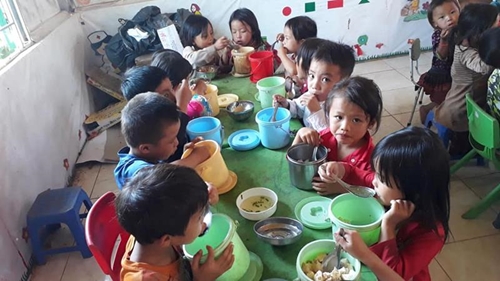Numbers speak
Reportedly, in Vietnam, one out of three ethnic minority children suffers from stunted growth, while one out of five is underweight. According to Deputy Minister of Health Do Xuan Tuyen, there remains the problem of malnutrition, especially in difficult areas where ethnic minorities live, including malnutrition and lack of micronutrients, such as iron, zinc, vitamin A, iodine.
    |
 |
|
Raising nutritional quality for children’s meals in Muong Nhe, Dien Bien |
The proportion of malnourished children is still high in Vietnam, especially in rural and mountainous areas in the North, Central and Central Highlands regions. According to the World Bank, the Southeast Asian nation is among 34 countries facing the highest burden of chronic malnutrition.
At the same time, malnutrition in children poses risks. Malnourished children show signs of retardation in physical and intellectual development. They are too short, too thin for their age, physically weak, and do not study well, as well as suffer from a number of diseases.
A survey conducted in 11 provinces of Vietnam by the Alive&Thrive project of the non-profit human development organization FHI360 shows that the exclusive breastfeeding rate among ethnic people remains too low (4-33 percent), and the rate of children enjoying appropriate diets in mountainous regions hovers around half of those in flatlands (the former’s 33-52 percent against the latter’s 75 percent).
The reasons are low awareness among ethnic minority mothers and a severe lack of food security. Meanwhile, various bad practices among ethnic minority groups are also a problem. For example, the Thai and Muong groups have poor diets and incomplete meals, while the Tay and Nung people generally wean children off breast milk too early.
Food safety also raises concerns among ethnic minority groups due to local climate conditions and poor post-harvest food processing technology.
Joining hands to take action
Minister and Chairman of the Committee for Ethnic Minorities Affairs Hau A Lenh held that the committee is chairing and working with relevant agencies to implement Program 1719 for the 2021-2030 period. Several projects under the program will focus on further boosting children’s rights and taking care of children.
    |
 |
|
H’Mong children in Sa Pa, Lao Cai |
Among them, there are major projects, namely Project 5 on “Education and training to improve the quality of human resources,” Project 7 on “Taking care of people's health, improving the physical condition and stature of ethnic minority people, and child malnutrition prevention,” Project 8 on “Realizing gender equality and solving urgent problems for women and children,” and Project 9 on “Investing and developing ethnic minority groups.”
Meanwhile, universal primary education, poverty elimination, mortality rate reduction, and improving health of women and children are concrete targets within the Millennium Development Goals. Thus, efforts made to fight malnutrition in children will contribute to realizing these targets.
As a result, the annual Action Month for Children is considered an opportunity for ministries, sectors, and local Party committees and authorities at all levels to enhance their responsibility to soon and effectively address malnutrition in children in general and those who are from ethnic minority groups in particular.
Translated by Minh Anh